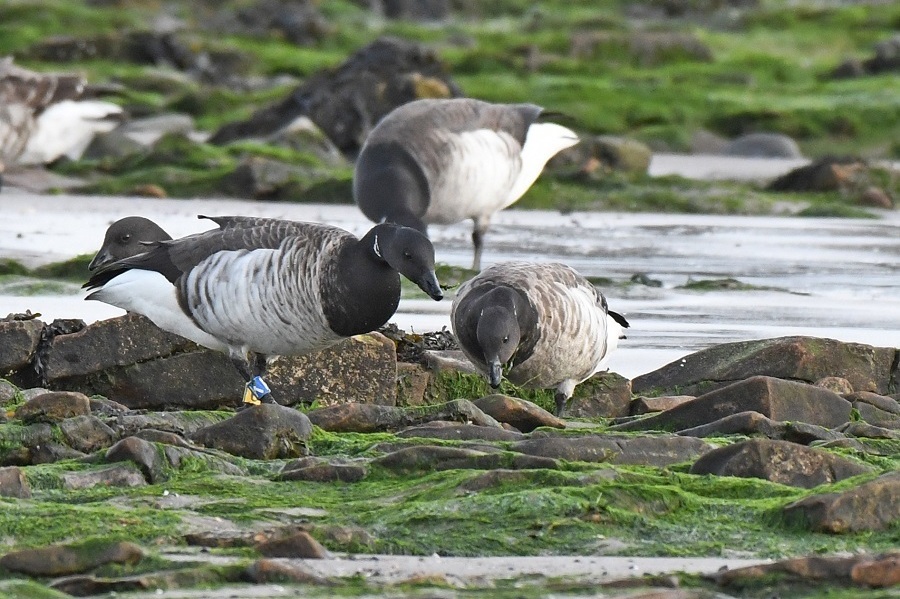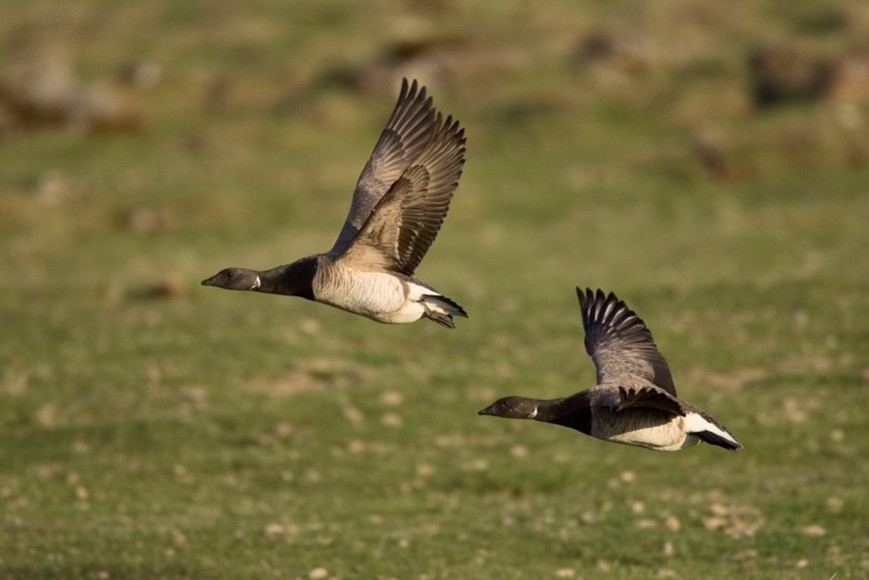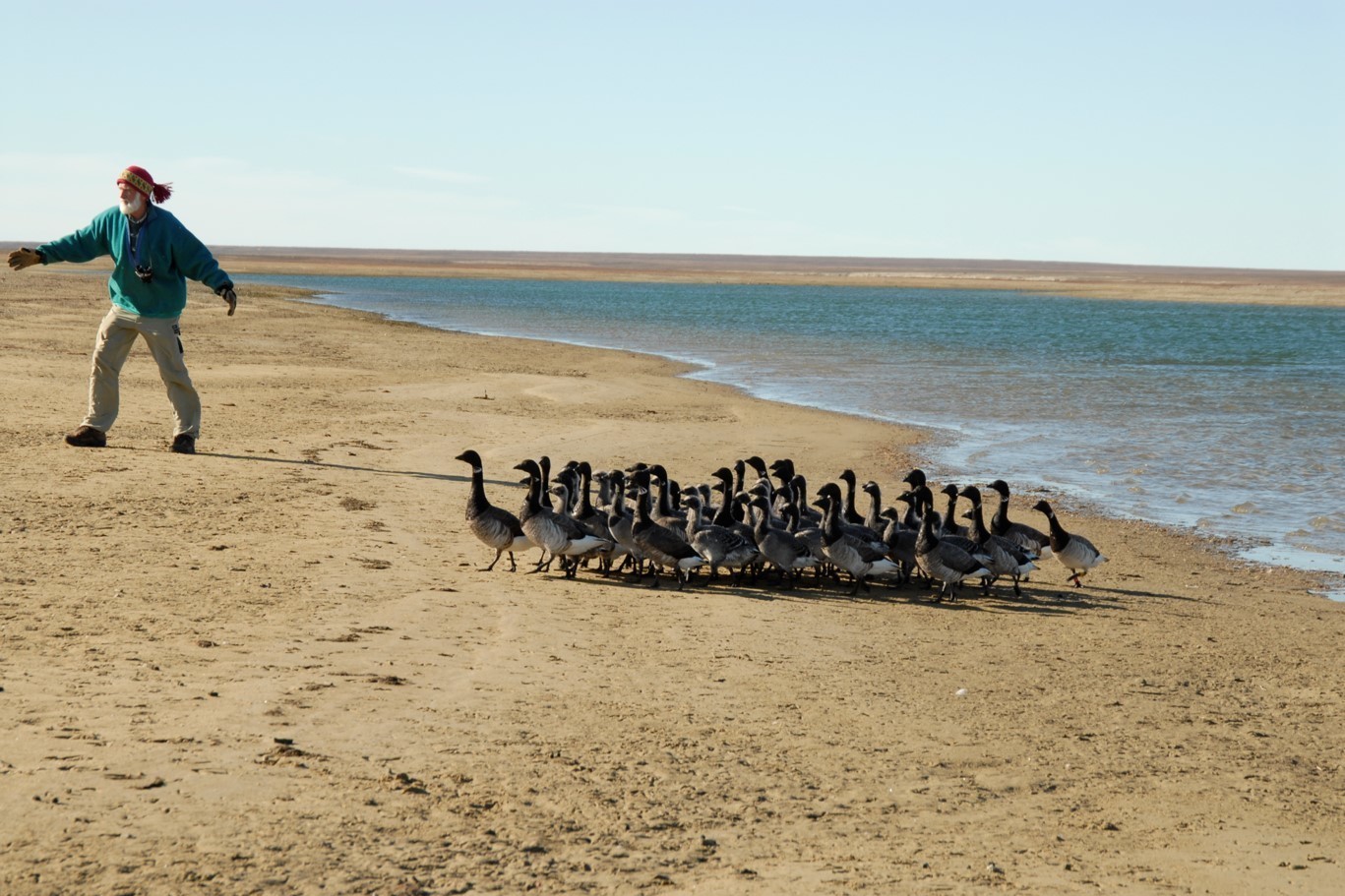SOME BACKGROUND HISTORY
Our study of this flyway population has grown massively over the last 20 years. The IBGRG ceased to exist for a period in the late 1980s and was rejuvenated in the mid-1990s co-incident with the start of the Irish Wetland Bird Survey (I-WeBS). At that point it was apparent that this survey could not adequately assess the size of the LBBG population nor even simple demographic elements such as annual productivity.
While the previous IBGRG carried out censuses, arctic expeditions and indeed colour ringing - very much focussed around Michael O'Briain's PhD work at UCD - there was an absence of colour-marked birds for a decade or so until 2001. At that point Alyn Walsh (NPWS) cannon-netted a small number (~30) of birds at the Wexford Slobs. In October 2003 we held an AEWA SSAP workshop at Castle Espie and at that point now Professor (then Dr) Stuart Bearhop and Dr James Robinson had just secured a PhD studentship (by the now Dr Richard Inger) looking at habitat switching in ECHA Brent at the most impoertant staging area at Strangford Lough - that was the start of what is now two decades of a very dynamic, busy and multi-faceted project. Due to other committments we have been less active on the project since around 2019, in part due to the Covid-19 pandemic restricting activites including travel, but also because we have not have a functioning resightings database. These issues are being resolved and launching this website is one step towards that.




RESEARCH AREAS
This project is thus about two things - (1) specific research questions about ECHA Brent that provide scientific information underpinning our understanding and enabling our conservation efforts for the population. The framework for this is outlined in a list of actions published in the 2005 AEWA SSAP. This report contains information on population dynamics, diet, distribution and movements and many of the causes and consequences of these parameters for light-bellied Brent geese throughout their entire flyway . (2) tackling wider research questions relating to long-distance migrants that our study population is almost uniquely able to address.
Migration is a remarkable behaviour but given its complexity our understanding of how individual migrating animals make their decisions and how this affects the population as a whole is limited, with many questions remaining. For example, we are still learning about how migratory animals manage trade offs within and among seasons and how these in turn drive variation in productivity, survival or breeding phenology. We study the ECHA Brent geese throughout the annual cycle, especially in Iceland (September/May) and Ireland (October - April). We have in excess of 5,000 individually-marked birds with comprehensive life history information available for individuals in a database containing in excess of 200,000 observations. An incredibly valuable dataset at the foundation of our research. Some of our current research areas of interest are described below and publications can be found here.
Host gut microbiome in Brent geese
In 2021/22 we embarked on a new project investigating how the host gut microbiome in Brent Geese mediates the relationship between foraging behaviour, body condition and reproductive success in the wild, via a Leverhulme project grant to Dr Xavier Harrison.
Successfully undertaking migration requires that Brent geese sequester large energy stores to finance the enormous cost of the migratory journey and subsequent reproduction. Significant research effort has been directed at understanding the processes driving variation in individual body condition (i.e. size of fat stores) and how that condition influences survival, reproduction and migratory performance. However, most studies tend to focus on individual diet as key drivers of condition – what do animals eat and how much of it do they eat? But this is only part of the story. We know for example that individuals differ in the efficiency with which they can metabolise nutrients, and this is expected to have knock-on effects on their ability to store fat resources. Though this phenomenon is well characterised in humans, comparable evidence from wild systems is scarce.
In fact, recent studies have highlighted that microbial communities living in association with animal hosts, often referred to as the ‘gut microbiome’, are responsible for shaping individual nutritional condition and digestion. Therefore, variation among individuals in their gut microbiomes may also drive differences in their nutritional health. However, the role that gut microbiomes play in the foraging ecology of wild migratory birds has been largely neglected. Though some studies have sought to understand the causes of gut microbiome variation in wild bird species, studies of the consequences of such variation for wild animal health and their links to fitness are exceedingly rare.
This work will have major implications for our understanding of the factors underpinning variation in body condition in wild animals. We propose that wild bird studies should incorporate knowledge of host microbiome alongside traditional metrics like diet and body condition to understand the factors shaping downstream reproductive success.
Movement and feeding behaviour of Brent geese in urban Dublin
Dr Tess Handby, as part of her PhD project, has been working in collaboration with the Dublin Bay Biosphere Partnership to GPS track fine scale habitat use by Brent geese in Dublin city and surrounding areas. This work was carried out over two winter field seasons spanning 2018 - 2020.
The Brent geese are known as capital breeding migrants because they rely on energy stored during the winter and spring staging periods to fuel their migration and breeding in the Arctic. Given this, the availability and accessibility of adequate food during this period is crucial to their survival and reproductive success. In this project we were specifically interested in the subpopulation of Brent geese spending the winter in Dublin City. Accessing food in this urban landscape can be complex because the geese are often exposed to human related disturbance. However, we have a limited understanding of the effects of urbanisation on migratory birds, specifically those relying on a range of habitat types, such as the Brent geese. To gain a better understanding of Brent goose foraging ecology, this project had two main aims:
1) Quantify habitat use, identifying movement patterns and behavioural responses across the rural to urban gradient in Dublin.
2) Understand the social factors influencing foraging behaviour on urban terrestrial sites.
We used innovative GPS technology to track the movement of the geese for the winter period. From this we were able to determine characteristics of the Brent's daily foraging trips (i.e. distance covered, distance from the roost). We found significant variation between the foraging trips of individuals feeding in a rural vs. urban landscape. Geese had to cover larger distances and relied on feeding sites further from the roost. This meant that the urban geese also had significantly larger home range. However, it was surprising to find that birds using different roost areas (including those <500m apart) had very little overlap in their home range (95% KDE).
This result alludes to strong social structure amongst the Brent goose population in Dublin, influencing their movement and feeding behaviour. To understand this social structure, we used resighting records contributed by the IBGRG and the local community to create a social network. Behavioural observations of known geese were also collected, recording proportion of time individuals spent feeding vs. alert. The results show that individuals spent more time feeding and less time alert when they were in a flock with familiar individuals. This suggests there is an adaptive advantage to hanging out with the same geese.
